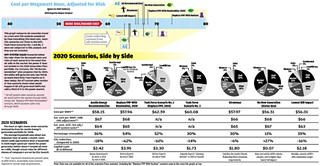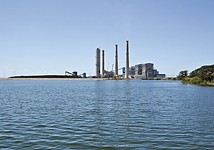AE's Coal Conundrum
Energy planners and the fight over Fayette
By Nora Ankrum, Fri., Nov. 20, 2009
"I think that we do need to ultimately close down those coal-fired power plants, but first we need to build the bridge to the new energy future."
– Scientist/environmental activist Tim Flannery, author of The Weather Makers
Perched on the shore of Lake Fayette, a well-stocked reservoir boasting an abundance of largemouth bass, the Fayette Power Project, just east of La Grange, strikes a stately, even handsome figure, rising benignly above the lake's serene waters – at least, as depicted in publicity photos. But beneath that distinguished surface, the Fayette coal plant, which provides about a third of Austin Energy's electricity, is also responsible for 71% of the utility's carbon dioxide emissions, an estimated 68% of its nitrous oxide emissions, and virtually 100% of its mercury and sulfur dioxide output. According to recent estimates of the National Research Council (based on 2005 data), the plant's health impacts cost Texans $200 million to $300 million a year.
Admittedly, those figures should soon change for the better. AE is nearly finished installing "SO2 scrubbers," which are expected to take a big bite out of its sulfur dioxide emissions – good news for Austin, just 60 miles downwind. Sulfur dioxide is one of the culprits responsible for acid rain. The airborne compound aggravates heart disease and is no friend even to healthy lungs. It's also expensive to clean up – AE's price tag for the scrubbers comes to about $230 million.
While a quarter-of-a-billion dollars is not chump change by anyone's standards, it's especially hard to swallow for those Austinites – such as environmentalist Chris Searles – who'd prefer simply to retire Fayette for good. AE should be "investing in local clean-tech infrastructure and more West Texas wind," says Searles, "instead of in mitigating pollution to keep the coal plant running."
AE has been working for more than a year to establish the ideal mix of solar, wind, biomass, coal, natural gas, and nuclear power – known as the 2020 Generation Plan – to provide most of Austin's electricity for the next decade. In August, AE made a proposal to City Council that surpasses many of the expectations of the Austin Climate Protection Plan, in part by ramping down use of Fayette by about a third (while "setting the stage for eventual sale or other disposition of Austin's share"). As reported last week ("Cool Cities: AE Task Force," Nov. 13), the council-appointed Austin Generation Resource Planning Task Force voted recently to support that proposal in a 5-4 vote, with the added caveat that AE revisit the possibility of chucking Fayette sooner. The Electric Utility and Resource Management commissions took their final votes on the matter earlier this week, and both supported the task force's recommendations. All four entities' recommendations will inform City Council's final decision; no date is set.
Swimming Upstream
Searles attended the Electric Utility Commission meeting along with energy consultant Mike Sloan, who served on the task force, and former ACPP Manager Jake Stewart. The three lobbied not on behalf of AE's recommendation nor on behalf of a scenario that closes Fayette by the end of 2020, though that was the most aggressive plan considered among the original dozen or so analyzed by city-hired Pace Consulting. Instead, they argued for an even bolder plan, proposing to free AE from its dependence on coal by the end of 2014.
Known as Task Force Scenario No. 1, the plan was among four developed by the task force, though in the end it secured only one vote: Sloan's. The plan's backers haven't lost hope. Searles and Stewart have launched a petition (www.budurl.com/austincpp) asking the city to "Recommit to Climate Protection," and Searles has been churning out blog posts about the plan on the Austin EcoNetwork and Burnt Orange Report websites. "I think if people knew more about the financial piece of it, then the support for it would grow really fast," he says.

According to Sloan's task force minority report, the scrubbers' $230 million price tag is the tip of the iceberg when it comes to the cost of dirty power. When you look at AE's $2.5 billion capital improvement projects budget over the last 12 years, he points out, you see it has funneled a mere fraction into renewables ($3 million in the past decade), while investing enormous sums in a fossil-fuel-based infrastructure. It then had to spend hundreds of millions more on the fuel itself. When you compare those numbers to the $2.4 billion capital outlay required by AE's plan – and its further savings on fuel costs – going green begins to look pretty cost-effective, says Sloan. So why not go even greener?
The more aggressively green plans do cost more in up-front investment. The scenario retiring Fayette in 2020 costs $3.9 billion. At $3.3 billion, Scenario No. 1 costs a little less than that because it substitutes cost-effective "demand-side management" (weatherization, rooftop solar, etc.) for more expensive resources like biomass – but supporters of more cautious scenarios charge that the plan is overly optimistic in this regard, relying too heavily on AE to spur private investment by customers. Still, what the more aggressive plans spend in the short term, they offset with long-term savings on fuel costs, which amount, for wind and solar, to zero. In addition, the plans protect ratepayers from future costs associated with carbon legislation and ever-tightening pollution regulations of the sort that require, say, millions of dollars on scrubbers.
But if you get rid of Fayette, responds AE General Manager Roger Duncan, "you've got to replace that energy – and there is nothing that you can replace it with, certainly in the short term, that's going to be as cheap." AE would likely have to buy natural gas from the volatile market to balance out the variability of sun and wind, but Sloan says that right now, market prices are lower than AE's average operating cost anyway. Regardless, he argues: "It's better just to buy power for a few years from somebody else. ... The dirty power we should rent and not own. We should focus on ownership in the things we really want." And as for Fayette providing a reliable source of baseload, Sloan says, upcoming changes in how the grid is managed by the Electric Reliability Council of Texas will make that point moot.
Task force member Cyrus Reed, conservation director of the Lone Star Chapter of the Sierra Club, helped Sloan develop Scenario No. 1 but didn't ultimately vote for it because of its "unknowns," such as heavy reliance on on-site solar. His first choice was the plan to retire Fayette in 2020, he says, but in the end he opted to "look for a consensus position to at least get us on the road toward getting out of the coal plant." Task force members Phillip Schmandt and Christine Herbert – who chair the Electric Utility Commission and the Resource Management Commission, respectively – wrote a report to council last week counting the 2020 scenario among the plans that are "realistic and feasible." While they ultimately support the task force's recommendations, they wrote, "If City Council believes that the costs of coal or future costs of complying with global warming legislation or other regulations governing the burning of coal justify the additional capital expenses associated with [retiring Fayette in 2020], then this scenario should be selected."
The task force members representing commercial and industrial interests have been less sanguine about up-front costs. Ultimately, they voted to support a resource mix they developed themselves, dubbed Task Force Scenario No. 2. It boasts the least expensive capital outlay but hangs onto Fayette, likely losing out on long-term savings.
Justifying the Means
In hopes, perhaps, of easing sticker shock, AE's plan leaves open to council the option of selling to the market the coal power it doesn't use. While AE's official proposal does not assume that the utility will sell off that power, Pace did run an analysis showing what the cost savings would be. When the task force members saw the glowing results, they wanted to know: What do other energy mixes look like when you sell excess generation? Pace ultimately analyzed several scenarios – though not Scenario No. 1 – with this assumption (see graph). Unsurprisingly, when you take Fayette entirely out of AE's mix – therefore freeing up 100% of its power to be sold to the market – it looks pretty impressive. (See graph.)
Of course, selling the plant, rather than retiring it, arguably misses the entire point. "You're still putting the same amount of emissions into the air as before," says Duncan, "and the whole idea of getting out of the plant ... is to reduce the emissions." Still, a case can be made that selling Fayette – or some of its power – would secure that much more money for renewables. "I would feel comfortable with the idea that you just sell [the plant] off, because if you don't, then maybe somebody else just builds a coal plant instead," says task force member Cary Ferchill of Solar Austin. "I don't think we can control how much carbon is put into the atmosphere by the world. We can only control the amount that we put into the atmosphere. ... I would say you just get rid of it because you don't want the continued risk of having a carbon-producing facility."
"It's an interesting argument," says Public Citizen's Tom "Smitty" Smith, "but our biggest fear is the impact of the emissions ... not only on our climate but on our nonattainment status." Not to mention, he adds, "the people who die prematurely as a result of our share of the emissions" and "the thousands of asthma cases that are triggered every year because of pollution."
Ultimately, the task force recommendation – with its proviso for revisiting the Fayette conundrum in two years – has earned the strongest support. Smith calls it "a big victory"; Schmandt and Herbert say it finds a "middle ground." But as an onlooker, Searles has been frustrated by the focus on the short-term. Scenario No. 1, he says, "shows much better financial management of the bill payers' interest." The longer AE waits, "the more regulation comes online, making us invest yet more in pollution controls. Then we're on the hook" for running the plant even longer, he says. "It's this downward spiral."
Meanwhile, Searles worries that concerns over relatively minor differences in cost may be overshadowing what's really important. "The whole idea that we're in a climate crisis has disappeared from these considerations," he says. "That big picture has gone away."
Got something to say on the subject? Send a letter to the editor.











